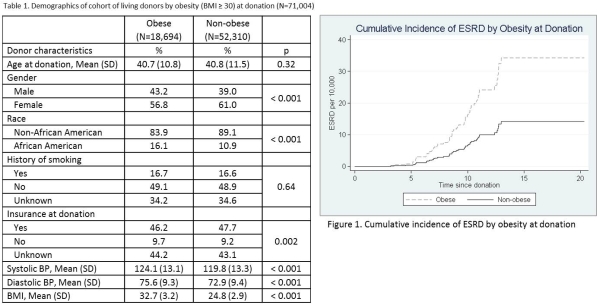Obesity Is Associated with Increased Risk of ESRD Among Living Kidney Donors.
1School of Medicine, University of Alabama at Birmingham, Birmingham, AL
2School of Medicine, University of Pennsylvania, Philadelphia, PA
3School of Medicine, Johns Hopkins University, Baltimore, MD.
Meeting: 2016 American Transplant Congress
Abstract number: 49
Keywords: Donation, Kidney, Obesity, Risk factors
Session Information
Session Name: Concurrent Session: Living Kidney Donation: Risk Factors for Adverse Long term Outcome
Session Type: Concurrent Session
Date: Sunday, June 12, 2016
Session Time: 2:30pm-4:00pm
 Presentation Time: 2:42pm-2:54pm
Presentation Time: 2:42pm-2:54pm
Location: Veterans Auditorium
Background: Living kidney donor (LKD) demographics have changed, and transplant centers have relaxed selection criteria to include LKDs who are obese. Prior studies of LKDs have failed to stratify donors by the presence of obesity. The goal of this study was to assess the risk of ESRD among LKDs with obesity at the time of donation.
Methods: 71,004 LKDs in the US (1994-2013) were studied. Obese LKDs were defined as donors with body mass index (BMI) ≥ 30kg/m2 at the time of donation. Donors were followed until the earliest of ESRD development, death, or administrative end of study. Maximum follow-up was 20 years; median follow-up was 7.3 years (IQR: 4.2-10.6) for obese LKDs and 7.4 years (IQR: 4.2-10.6) for non-obese LKDs. Main outcome measures included cumulative incidence and adjusted risk of ESRD (adjusted for age, race, blood pressure, and insurance status).
Results: Compared to non-obese LKDs, obese LKDs were more likely male, African American, and to have higher blood pressure.  ESRD developed in 0.14% of obese LKDs in a mean (SD) of 8.9 (2.8) years after donation; ESRD developed in 0.05% of non-obese LKDs in a mean (SD) of 8.0 (2.1) years after donation. Estimated risk of ESRD at 20 years after donation was 35 per 10,000 for obese LKDs and 14 per 10,000 in their non-obese LKD counterparts (p < 0.001). LKDs with obesity had a 2.29-fold increased risk of ESRD compared to non-obese LKD (adjusted hazard ratio (aHR): 2.29, 95%CI: 1.34-3.93, p=0.003). For each one unit increase in BMI, there was an associated 8% increase in the risk of ESRD (aHR: 1.08, 95%CI: 1.03-1.13, p=0.001).
ESRD developed in 0.14% of obese LKDs in a mean (SD) of 8.9 (2.8) years after donation; ESRD developed in 0.05% of non-obese LKDs in a mean (SD) of 8.0 (2.1) years after donation. Estimated risk of ESRD at 20 years after donation was 35 per 10,000 for obese LKDs and 14 per 10,000 in their non-obese LKD counterparts (p < 0.001). LKDs with obesity had a 2.29-fold increased risk of ESRD compared to non-obese LKD (adjusted hazard ratio (aHR): 2.29, 95%CI: 1.34-3.93, p=0.003). For each one unit increase in BMI, there was an associated 8% increase in the risk of ESRD (aHR: 1.08, 95%CI: 1.03-1.13, p=0.001).
Conclusions: Compared with non-obese LKDs, LKDs who are obese at the time of donation had an increased risk of ESRD within 20 years of donation. These findings may help to inform selection criteria and discussions with persons considering live kidney donation.
CITATION INFORMATION: Locke J, Lewis C, Reed R, Kumar V, Sawinski D, Massie A, MacLennan P, Mannon R, Gaston R, Segev D. Obesity Is Associated with Increased Risk of ESRD Among Living Kidney Donors. Am J Transplant. 2016;16 (suppl 3).
To cite this abstract in AMA style:
Locke J, Lewis C, Reed R, Kumar V, Sawinski D, Massie A, MacLennan P, Mannon R, Gaston R, Segev D. Obesity Is Associated with Increased Risk of ESRD Among Living Kidney Donors. [abstract]. Am J Transplant. 2016; 16 (suppl 3). https://atcmeetingabstracts.com/abstract/obesity-is-associated-with-increased-risk-of-esrd-among-living-kidney-donors/. Accessed December 9, 2025.« Back to 2016 American Transplant Congress
